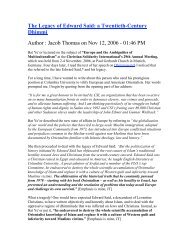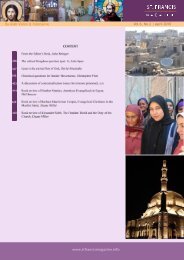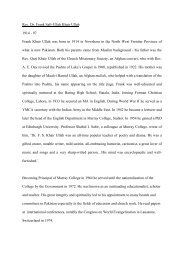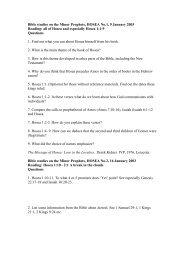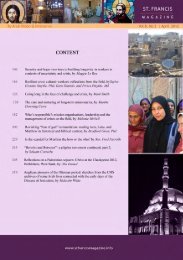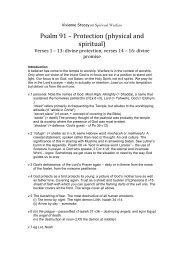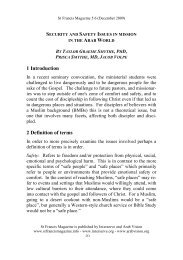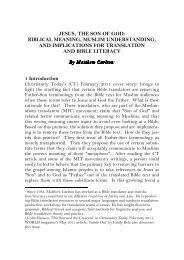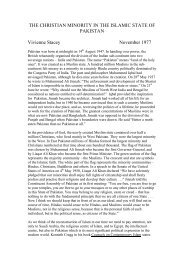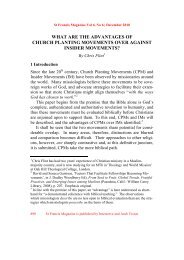download the pdf - St.Francis Magazine
download the pdf - St.Francis Magazine
download the pdf - St.Francis Magazine
You also want an ePaper? Increase the reach of your titles
YUMPU automatically turns print PDFs into web optimized ePapers that Google loves.
<strong>St</strong> <strong>Francis</strong> <strong>Magazine</strong> Vol 8, No 4 | August 2012<br />
picked up by o<strong>the</strong>rs within <strong>the</strong> debate; certainly, as later writers<br />
would demonstrate, <strong>the</strong>re remained much exegetical work to be<br />
done beyond simple collection and assertion of texts.<br />
Two important <strong>the</strong>oretical distinctions underpinned Massey’s<br />
argument. First, he distinguished conversion from discipleship, seeing<br />
<strong>the</strong> call of Jesus as requiring <strong>the</strong> latter but not <strong>the</strong> former (Massey<br />
1999: 191), arguing for a parallel with Paul’s opposition to ‘Judaisers’<br />
demanding gentile conversion to Judaism in order to follow<br />
Jesus. Second, since identity is not based solely on one’s <strong>the</strong>ological<br />
position, <strong>the</strong>re remains room for followers of Jesus to continue identifying<br />
as ‘Muslim’ in name, in sharp contrast to <strong>the</strong> strategic stance<br />
adopted by C1-C2 believers. 14 Recognising <strong>the</strong> controversial nature<br />
of this proposal, Massey sought a moratorium on “missiological<br />
gossip,” whereby believers fur<strong>the</strong>r up <strong>the</strong> spectrum are accused of<br />
diluting <strong>the</strong> gospel via “compromise, syncretism and heresy” to render<br />
it more palatable, even while believers fur<strong>the</strong>r down <strong>the</strong> spectrum<br />
are charged with “obstructing <strong>the</strong> flow of <strong>the</strong> gospel with a<br />
culturally insensitive, extractionist approach” (Massey 1999: 193). 15<br />
In a similar vein, ‘early adopters’ of C5 should resist pride, and<br />
avoid considering <strong>the</strong>ir approach is for everyone.<br />
Instead, Massey submitted, <strong>the</strong> Acts 15 Council (specifically,<br />
15:19) provides a better, third response which would accommodate<br />
C5 ministry, one which models an acceptance of God’s diversity in<br />
mission infused with praying for God’s blessing upon those with a<br />
different approach to ministry (Massey 1999: 194). Continuing this<br />
emphasis on diversity, Massey also stressed <strong>the</strong> variegated nature of<br />
<strong>the</strong> Muslim world and <strong>the</strong> commensurate need for diversity in<br />
bringing <strong>the</strong> gospel to it (Massey 1999: 194-196), as had Travis in<br />
14 A C1 church operates in an outsider language and cultural setting, with no<br />
concession to <strong>the</strong> local situation. By way of illustration, <strong>the</strong> Armenian churches in<br />
Iran would be classed as C1 (Richard 2009), whereas a C2 ministry would consist of<br />
“traditional church using insider language” (Tennent 2010: 303). C1-C3 would<br />
identify <strong>the</strong>mselves as ‘Christians’ (Travis 1998a).<br />
15 ‘Extraction’ here indicates converts withdrawing from <strong>the</strong>ir familial and society<br />
setting, and becoming inserted into new and alien church cultures, ei<strong>the</strong>r at <strong>the</strong>ir<br />
own instigation or under <strong>the</strong> direction of a missionary.<br />
<strong>St</strong> <strong>Francis</strong> <strong>Magazine</strong> is a publication of Interserve and Arab Vision 460




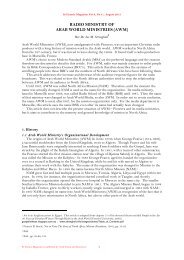
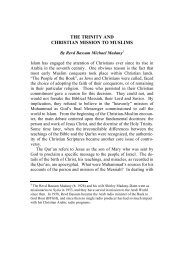
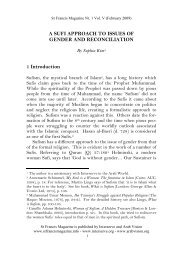
![Reflections on Surah Fatiha and the Lord's Prayer[1] - St.Francis ...](https://img.yumpu.com/49377951/1/184x260/reflections-on-surah-fatiha-and-the-lords-prayer1-stfrancis-.jpg?quality=85)
